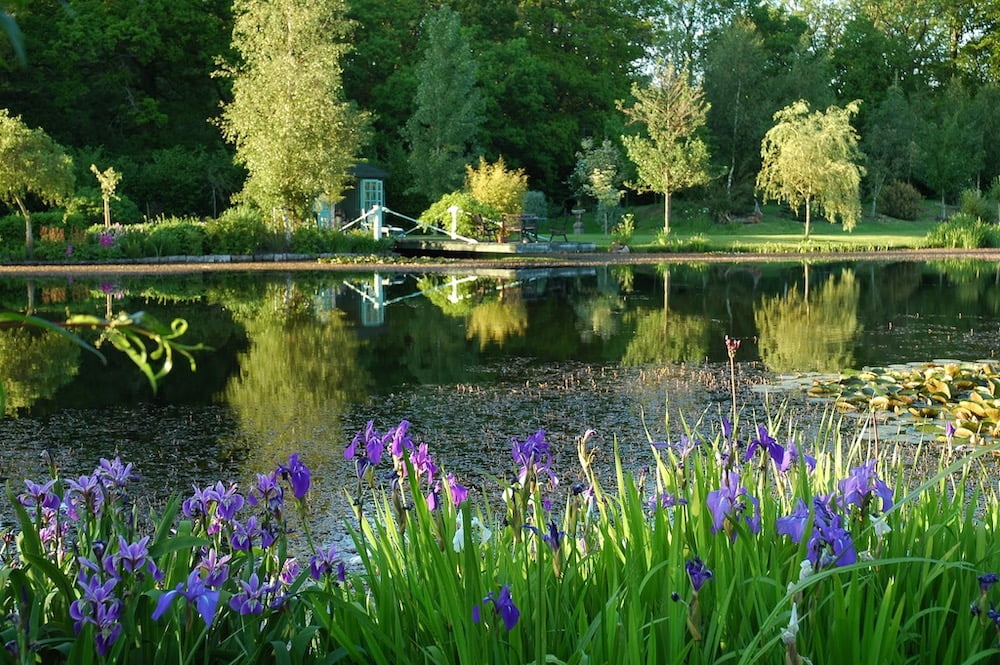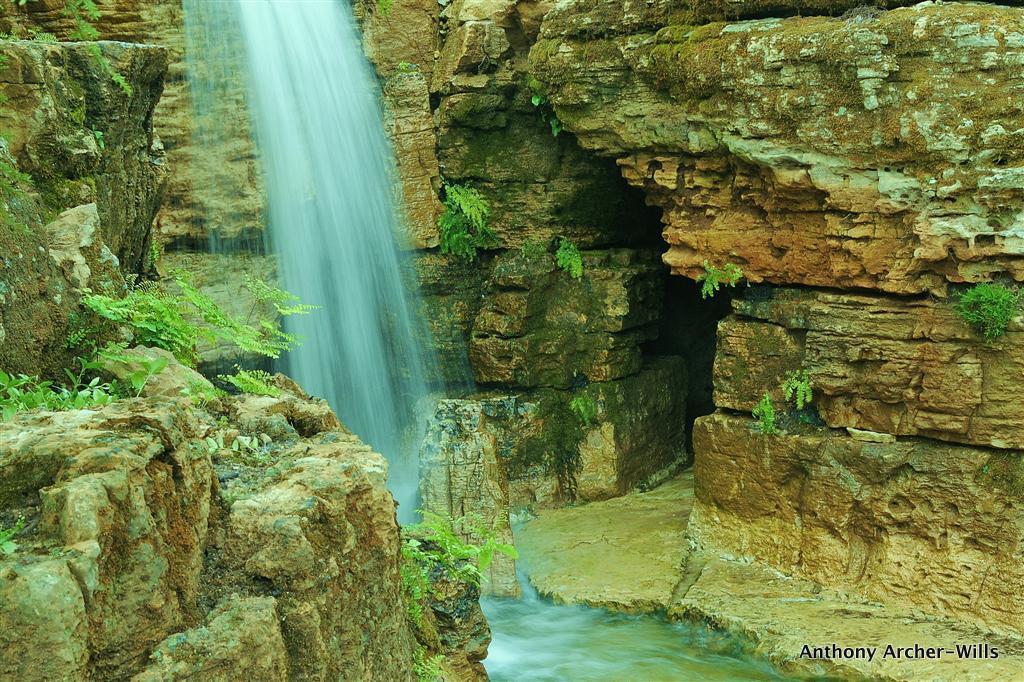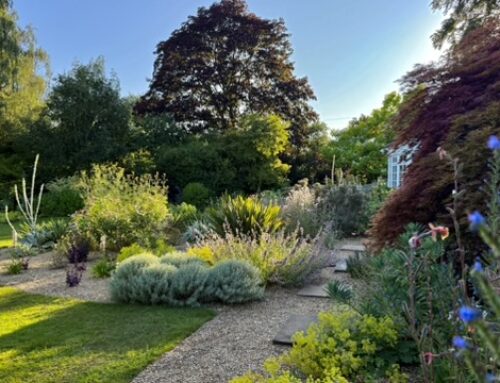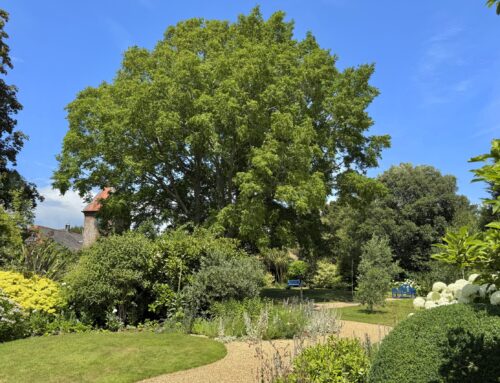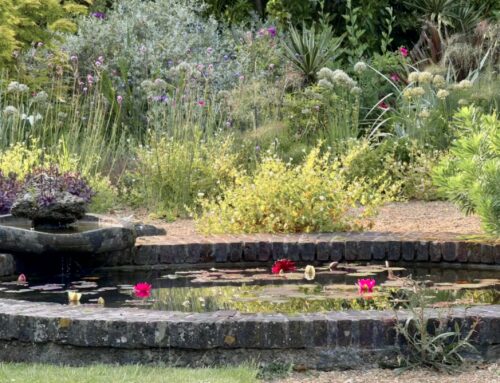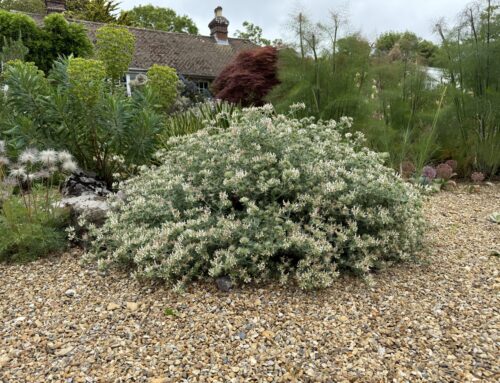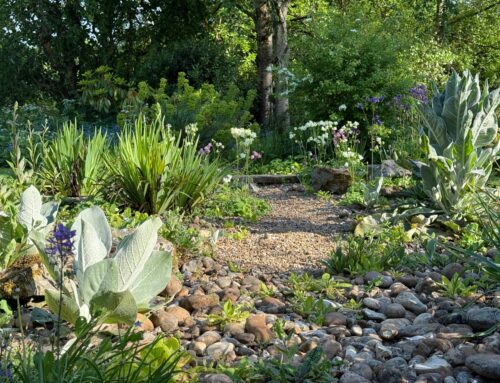A waterfall, part of a vast, finished water garden in Pawling, New York.
Denmans Garden, which John Brookes MBE called home from 1980-2018, is also where he ran his Clock House School of Garden Design. This month marks what would have been his 90th birthday as well as five years since the reopening and restoration of Denmans, an undertaking initiated shortly before his death.
In this light we are delighted to speak to Anthony Archer-Wills, the celebrated and award-winning water garden designer. Anthony, whose 50+ year career has included vast water projects around the world and included a stint as ‘The Pool Master’, knew John well and helped him realise the design of the pond at Denmans Garden in 1984 which replaced the dry waterhole where Mrs Robinson has originally terminated her riverbeds.
Fortunately for us, Anthony continues to return to Denmans, most recently to help work on the pond in the gravel garden in front of the cottage.
I wonder if one inherits a bit of this fascination with water. My grandmother was a Cavendish and my mother used to play in the great cascades at Chatsworth. The family were all inventors of one kind or another and involved with water. Who knows?
I was brought up on a farm with a pond and a lake close by. I was made to swim at a very early age and once I proved that I could swim adequately, I was allowed freedom to do as I pleased. On the lake there was an old punt, and I would push out from the dark enclosure of the boathouse to this sparkling, brilliant aquatic world, through the lily pads, and for me this was magical.
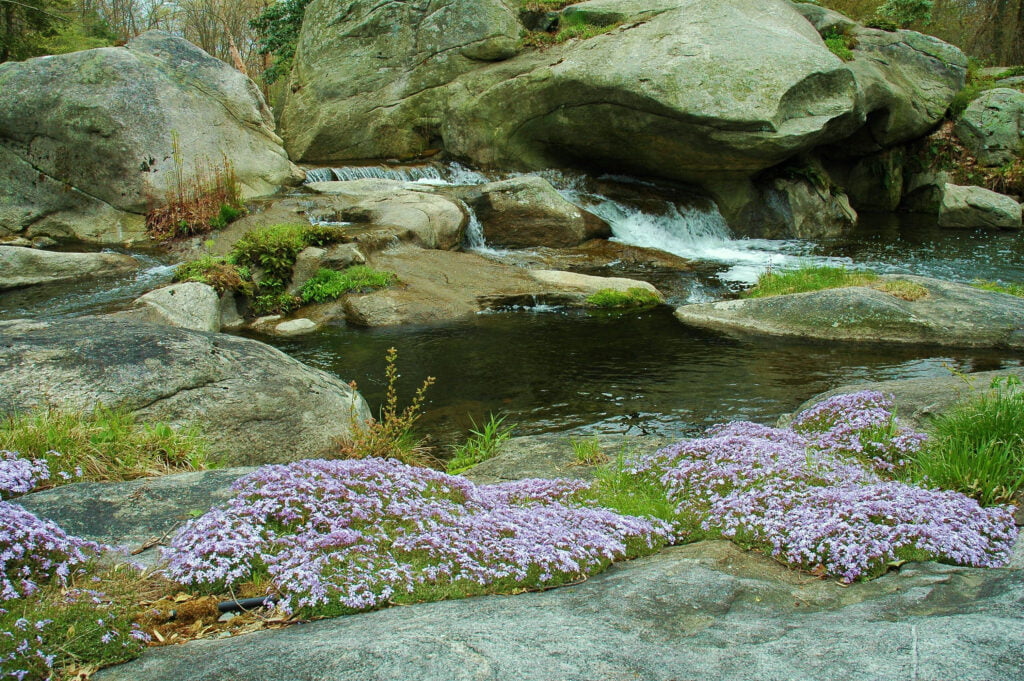
Creeping phlox, one of Anthony’s favourite plants, evokes pools of water beside this water course, part of a massive water project and estate in Pawling, New York.
At the same time my boarding school grounds had springs and pools and on a Sunday afternoon we were free to do what we liked (more or less) and would go out into the woods to make dams. The Big Pond was like an underwater garden, full of fascinating plants and little creatures. Being brought up in a watery environment was most formative. I just loved to see the emerald-green Water Starwort billowing up from the bottom. As soon as I was able to, I made a pond for myself that in hindsight was hideous. I dug the hole by hand and mixed concrete on the garage floor. But now I had my own little water world – it was a wonderful experiment and challenge. This was soon followed by more ponds and a stream.
As I increased my collection of water plants and fish, gradually people would come and visit. They would share my fascination. I was asked to come and build ponds for them – I was about nineteen and things gradually built up by word of mouth. Eventually, I had a small team and then brought another property for machinery and water troughs and greenhouses – so my career and business built up from building ponds from scratch and much trial and error.
I knew John Brookes for a long time from his early days – John was such fun to be with and he possessed an infectious hyena-laughter. You had to hear it to believe it and you couldn’t help but laugh along with him. It was delightful.
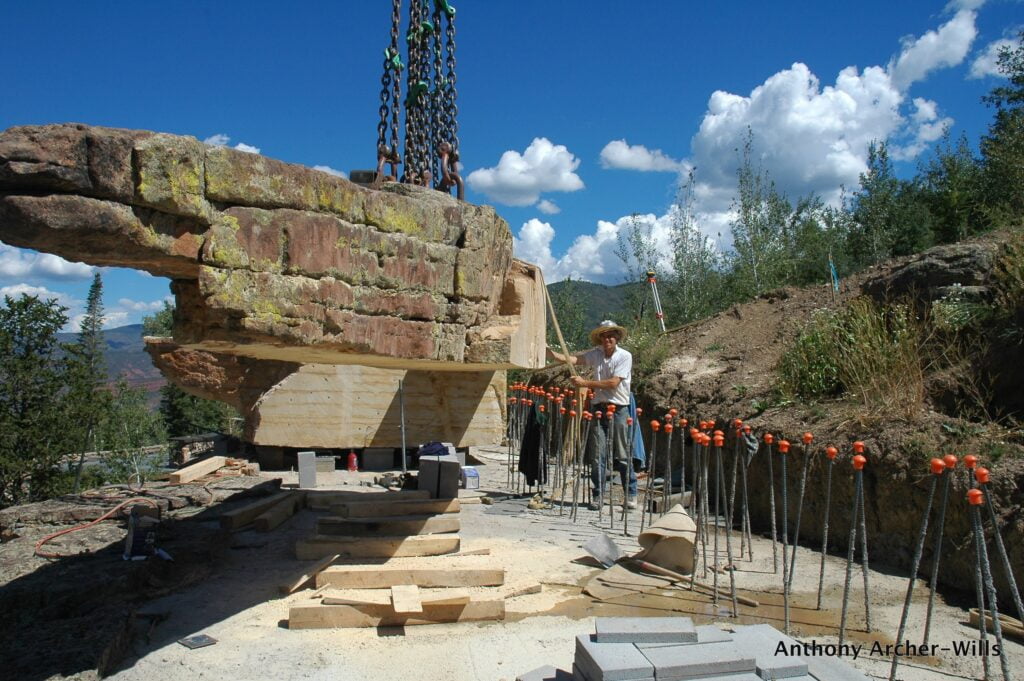
Anthony at work on a native garden in Aspen, Colorado.
One of his first garden designs included a curious kite shaped pond which I built for him. It opened my eyes to the opportunity of formal ponds that reflected the formality of the gardens. John said if you look around you the shape reflects the walls of the surrounding garden…the pond was a miniaturised version of the garden. I lapped up information from John and designers like Rosemary Verey and Rosemary Alexander and having had no formal training I loved what they had to say and listened intently. Alan Fradd whose family-owned Toynbee’s nursery was another great mentor of mine. He would say, ‘You mustn’t just look at your feet – look at the distant hills, forest, mountains. Your landscape must relate to those.’ He and John spread my gaze to the distant horizons. That’s how I gleaned my knowledge.
John would take me on trips and he somehow acknowledged that I specialised in water and in a way, he liked my support and opinion. He invited me to visit him at La Napoule in the south of France just to the West of Cannes where he lectured. He had a project in Ardennes in South Belgium which he invited me to and we arrived in deep snow. We were floundering knee deep and discussing the landscape which you couldn’t see!
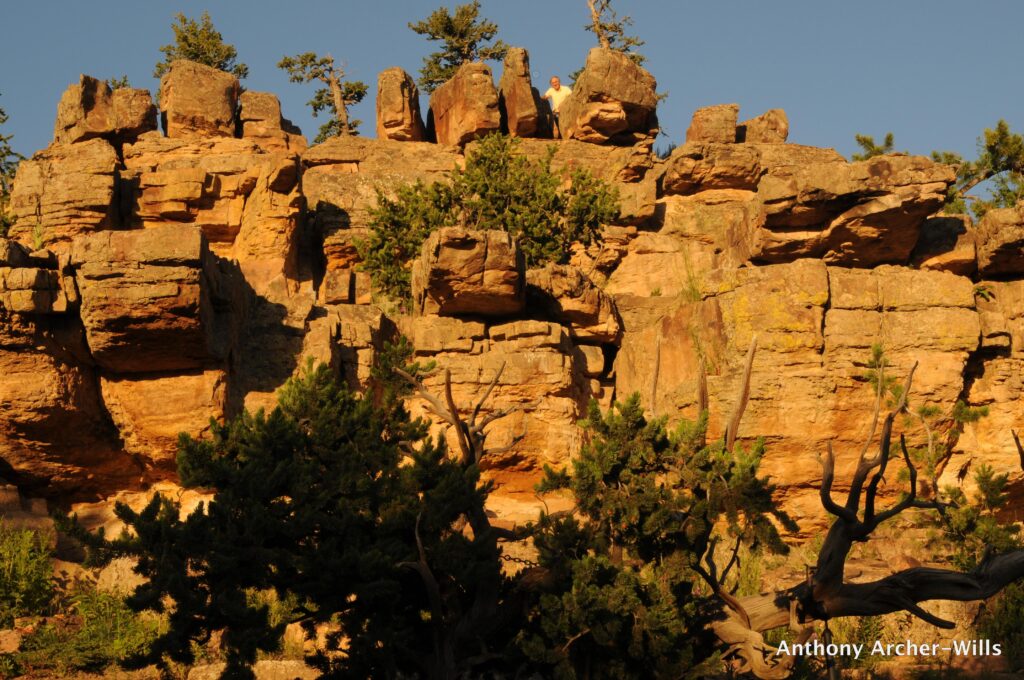
Looking at the distant hills, forest, mountains: Anthony creating stunning waterworks in Aspen, Colorado.
I had started lecturing myself by then and John invited me to do the water lectures at his Clock House school of design at Denmans. It was the most enjoyable and civilised lecture experience I’d ever encountered – I describe it as walking into a purr of cats – contented cats draped on sofas, with students dotted around with their drawings and at the end of the morning John would come in with a silver tray with white wine. It was so far removed from anything I had experienced in my education at boarding school.
It was lovely to have this setting and because it was so relaxed and fun everyone learned so much because although John was tough, he wasn’t intimidating. It was a real ‘thinktank’. I remember on one occasion he came out with a rather surprising statement. He was annoyed that the students couldn’t get their curvy lines, lovely sweeping soft lines – he said ‘I’ve explained this before – it’s tits and bums – that’s what you should be thinking of…lovely smooth, rounded curves. Harmonious and fluid’!
The interesting thing about John’s work is he that he would contrast the naturalistic soft lines that he loved with strict formality, and when formality was called for – for instance to be faithful to the architecture of a building he would stay true to that. But he did love those naturalistic lines, wonderful curves that nature would typically use.
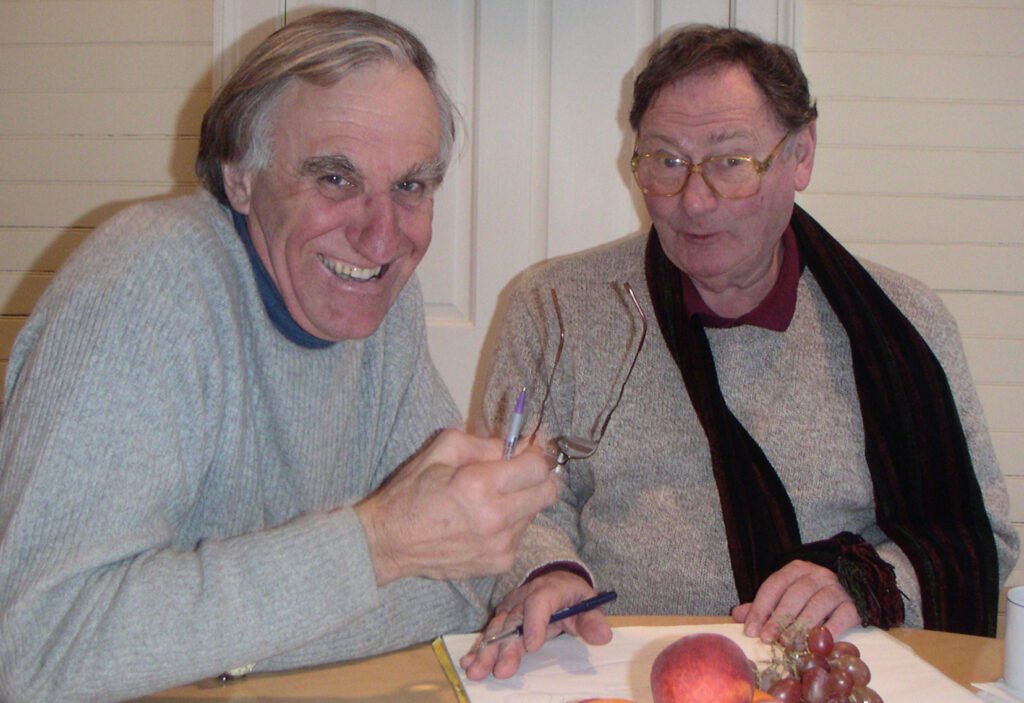
Anthony at work with John on a design for lakes, rivers, and waterfalls on a New York estate.
Mrs Robinson was still around at Denmans at this point and very much still at the helm. She was a typical wonderfully eccentric, outspoken English character. She would whizz me around in her buggy and try to trip me up on my plant identification – a simple task in which she always succeeded. Her horticultural knowledge was immense, and she would tell me off for my lack of plant knowledge. Hers was remarkable. She was a similar and outspoken plant-aficionado like Christopher Lloyd with whom I worked for many years. He would also supply lavish helpings of joy in the form of Champagne lunches. Christopher would not tolerate people trying to be clever with him. He hated affectation, and I saw that in Joyce too.
I’ve been in garden design for over 50 years and learned a lot from people like John and through things I saw travelling – the Romans’ work, and the countries of Turkey and Argentina for example. John told me early on, when I asked for his advice – he swung my gaze far out from the landscape I was working on near Chichester – although it was probably 8 miles away, he advised to use the Chichester cathedral spire as a focal point – he, too, taught me to look at the big picture.
John had a class at Kew that I taught with him, and we would critique the water features at the end of the session and would go around with the students and ask their opinion – how would you make it better? Would you change anything? This helped them look with a critical eye with a view to making improvements.
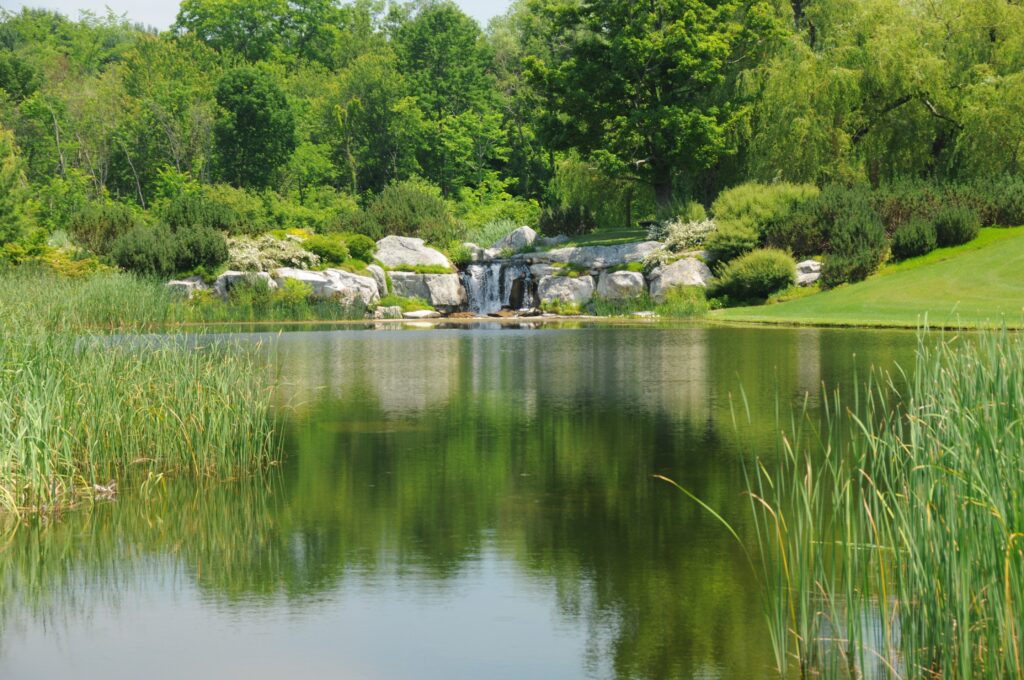
The lower waterfall in a series of water features designed by John Brookes and built by Anthony.
Working with John was an enormous privilege. We worked on a project at Altamont in the U.S – still ongoing – it was so much fun and that’s what life should be. Work hard but enjoy what you do. I had good fun working and lecturing with another garden designer – Robin Williams – we had such a good rapport. Humour in a classroom is disarming and helps people relax and learn.
I love teaching and always learn something from the students – it’s a two-way process. Performing to large audiences and lecture halls can be intimidating – but I put myself in a different mindset – instead of fear, share the fun I have experienced and get the audience to laugh to break the ice.
My first talk back in the day was to Thakeham Garden Club and was so hard. They asked me to speak about the water plants I had been growing but I was so shy, I was terrified. I believe that I was the shyest boy in boarding school! The notes were useless as I couldn’t see them in the dark while I operated the slide projector, and a woman heckling me to ‘speak up!’ That made me hit rock bottom, I wanted the floor to swallow me but honestly in that situation the only way is upwards. and I carried on from there.
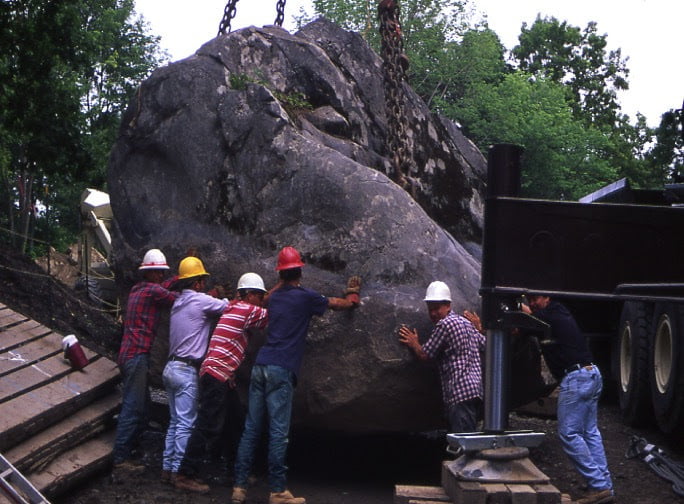
The perfect placement of placement of rocks is one of Anthony’s many gifts. This one weighs in excess of 200 tons.
My wife Pauline and I are now based in upstate New York where we have been for about seven years. When we bought the house, it was dark and poky but with a wonderful view. Views to the West, with all the evening sun and beautiful sunsets and surrounded by 15 acres with woods beyond. The garden has the 1-acre pond I made, has mountains in the distance and a more formal garden with fountains and flagstones by the house. I originally came to the U.S in the ‘eighties on a lecture tour for New York Botanical Garden and ended up staying doing lengthy projects.
Most days now I spend drawing and I have various projects on the go. I spend a lot of my time doing consultancy. It’s an unpredictable business. We have projects that get cancelled or postponed – there are so many variables. My wife helps with everything. Pauline is my brain and hard drive with a sound head for figures.
Some of my projects are wonderfully challenging and working with granite and schist is tough – the rocks are very complex. Sandstone and lime which prevails in a lot of Europe is much more malleable and can be fitted together most successfully. Then, there are the hydraulic challenges. Some that I have encountered in the UAE and Ukraine were on a scale, quite monumental! They required meter diameter pipes and lots of horsepower.
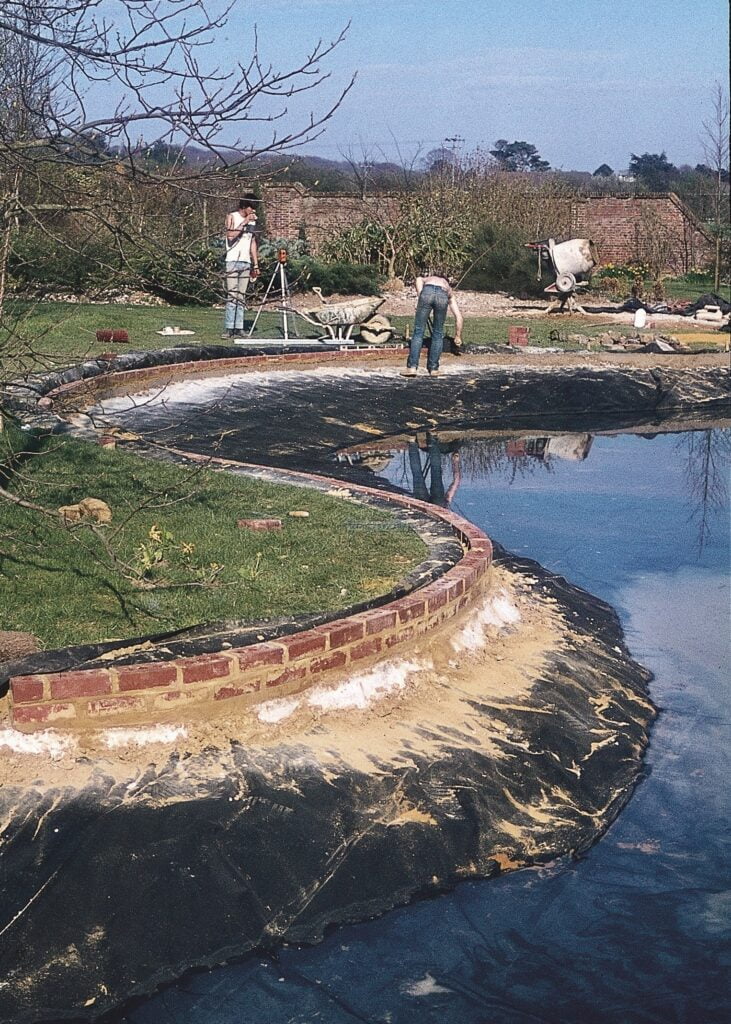
Building the lower pond at Denmans, which was designed by John Brookes as a termination point for the dry riverbeds created by Joyce Robinson. It was restored in spring 2018 and is maintained with Anthony’s help.
At Denmans, John drew up the design for the bottom pond as a natural end to Joyce’s dry riverbeds. I worked with him on the pond. When we did it, the high hedging and trees weren’t there. We didn’t have any super pond digging equipment. just a little tractor with a bucket. It was a long task digging it out, but I had some wonderful guys, one was brilliant at brickwork. The pond is tricky now because when originally designed it was much more open with nowhere near the leaf fall and darkness that the pond has now. To maintain it as it was originally intended is not possible, so we have to decide what to do. Opening it up means exposing the garden to the neighbour, but the pond is somewhat compromised, and we have to rethink what to do – design something like a biofiltration system to keep it pure or a skimming system. There’s no silver bullet. It is of course an important aspect of the garden – the culmination of the gravel stream, so it feels logical to have it there.
I’ve recently done a lot of improvement to the circular pond in the cottage garden. Now it’s so pretty with the waterlilies.
I like the ‘Alice’s garden’ element of Denmans – the hidden places and the wonderful surprises. Every corner has a fresh vista and surprise, and you are drawn round the garden by a series of invitations. Like the Chinese garden principle. Denmans is small and surrounded by a wall and yet it feels much bigger because you never see the whole. There is always a sense of mystery, and hidden places – going through an opening and finding another gem or hidden secluded spot with a bench and I love that. I’m really fond of the walled garden. It is so special, with such a wealth of plants. It’s so warm, and intimate and cosy.
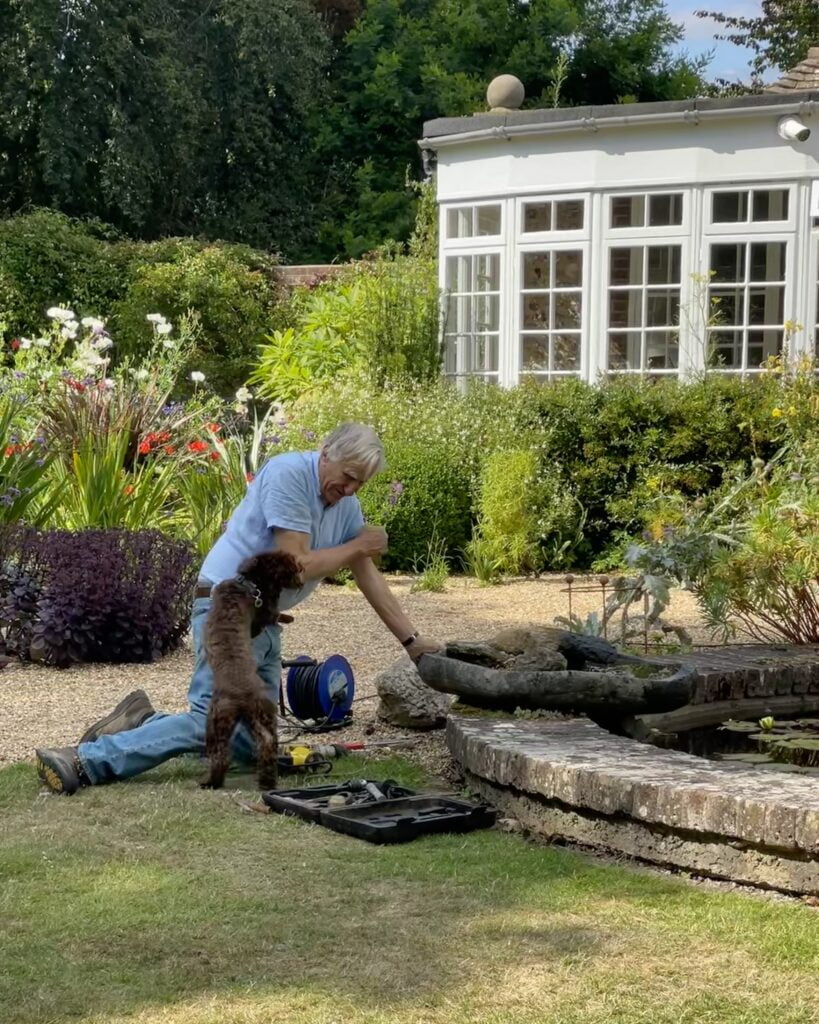
Anthony putting the long-defunct 1982 water fountain in working order in front of the Cottage in July 2023 with a little help from a canine friend.
Visiting Denmans now is to see the most remarkable transformation; dare I say it even better than when Joyce and John had it. It’s amazing what Gwendolyn and Mike have done. Gwendolyn is so energetic and tenacious. Sometimes in the end the student is better than the master because they have learnt so much and are not starting from scratch. Gwendolyn has thrown herself unconditionally into the project, whereas John was away working and could give it only so much. Gwendolyn has elevated what was there, it’s amazing. I think John would be so thrilled. I can just hear his infections cackling laughter. Although as a fierce critic too – I’m sure he would have things to say!
For more information about Anthony Archer-Wills go to https://www.archerwills.com/
For more information, please contact Louise Campbell
louise@denmans.org 07540892364
@denmans_garden
